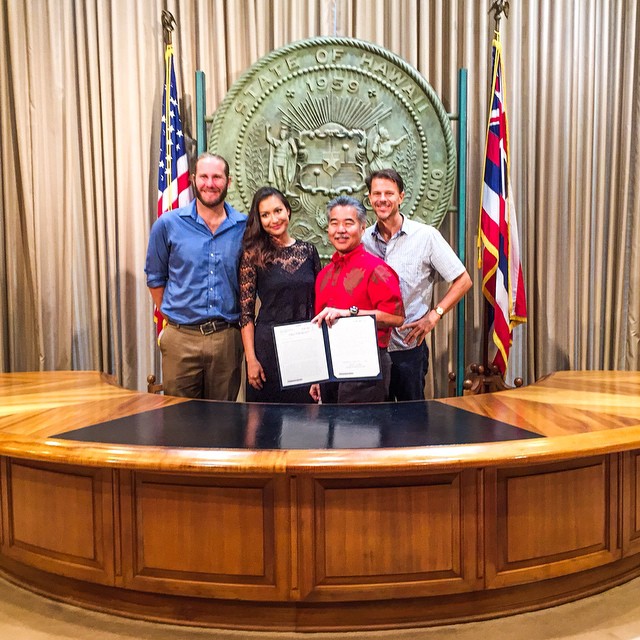
 Imagine spending the day with your family at a beautiful beach on Kauai and playing in the waves and water all day till you’re exhausted and sunburned. But later that night, you start to develop a bad skin rash or a severe stomach bug, and you wonder if the water was contaminated. But where were the warning signs?
Imagine spending the day with your family at a beautiful beach on Kauai and playing in the waves and water all day till you’re exhausted and sunburned. But later that night, you start to develop a bad skin rash or a severe stomach bug, and you wonder if the water was contaminated. But where were the warning signs?
Water quality is something most people take for granted…until they get sick and the issue suddenly hits home. Although Hawai‘i is known for its pristine beaches and waters, Surfrider’s Kauai Chapter has revealed that there are some chronically polluted streams that flow directly into a number of popular beach parks.
Likewise, on the Eastside of Oahu, the Hawai‘i Department of Health (DOH) has reported that several coastal areas have severely impaired water bodies. In some areas like Kahalu‘u on Oahu and Waiopoli Stream on Kauai, some of the bacteria levels are dangerously high and more than 100x the allowable limit. Along with the environmental concerns, this is a major threat to human health.
Under the leadership of Dr. Carl Berg, the Kauai Chapter’s Blue Water Task Force volunteers consistently test water quality at more than 25 sites, looking for signs of fecal contamination. In 2014, five locations — Waiopili Stream in Mahaulepu, Waikomo Stream at Koloa Landing, Niumalu County Beach Park near Pu‘ali Stream, Hanamaulu Stream and Pakalas surf break — were polluted 100% of the time. Nawiliwili Stream and Gillin’s Beach exceeded bacteria standards over 90% of the time.
What are the sources of this contamination? Like most states, the leading cause of water pollution in Hawai‘i comes from stormwater runoff, especially the “first flush” after a heavy rain. But unlike the rest of the country, the second leading source comes from the state’s high number of cesspools that leach untreated effluent into nearby streams, water sources and coastal areas.
Hawai‘i has the dubious distinction of having the highest number of cesspools in the country, and it’s the only state that still allows new ones to be constructed. The last state banned them more than 50 years ago! The Surfrider Foundation has been working with Hawai‘i’s DOH and state legislators over the last few years to create policies to reduce the amount of cesspool seepage, especially from those near streams or water bodies.

The good news is that Surfrider supported and helped pass two new laws that will reduce water pollution. Act 42 targets runoff from stormwater, and Act 120 will give homeowners in selected areas a $10,000 tax credit to upgrade their cesspools. This is a strong start, and we were stoked to be invited to the bill signing ceremony at Governor David Ige’s office. But our members are still very concerned about the lack of signs at the already contaminated areas.
At the urging of the Kauai Chapter, DOH’s Clean Water Branch posted one warning sign in Hanalei River a few years ago, and under mounting public pressure, they recently posted others in Kahalu’u. Surfrider’s Oahu Chapter has relaunched its Blue Water Task Force to monitor water quality around the Island. See where the Kauai and Oahu Chapters are testing and view their latest data here: Kauai, Oahu. Both the Kauai and Oahu Chapters have also posted an Ocean Illness Reporting Form on their websites to gather information on where people are getting sick from exposure to polluted water.
 Now, Surfrider’s Hawai‘i Chapters are asking the Clean Water Branch to post more warning signs in the most polluted streams and public beach parks where people recreate. These include the five areas listed above on Kauai and those on Oahu’s East and North Shores, where there are many cesspools and dangerously high bacteria levels in certain parts.
Now, Surfrider’s Hawai‘i Chapters are asking the Clean Water Branch to post more warning signs in the most polluted streams and public beach parks where people recreate. These include the five areas listed above on Kauai and those on Oahu’s East and North Shores, where there are many cesspools and dangerously high bacteria levels in certain parts.
The Hawaii Chapters have also reached out to the EPA and will be forming an Action Alert to ask DOH to follow their own rules and guidelines and post warning signs in streams and beach parks that are chronically polluted. Whether you’re a local or a visitor to the Islands, we all want clean water. But if our streams and beach parks become contaminated, we at least deserve a warning sign.